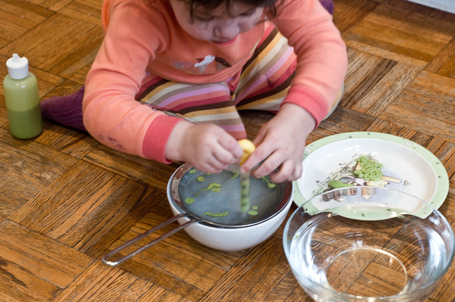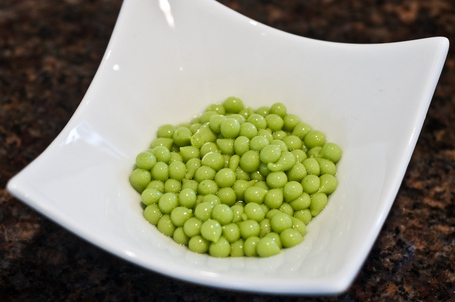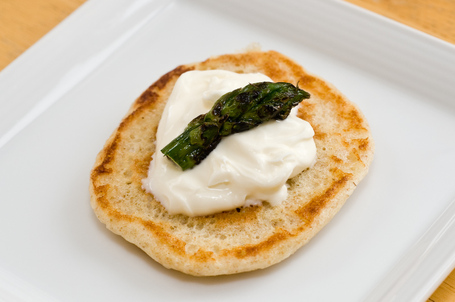Blini With Asparagus Caviar, When Three Year Olds Do Molecular Gastronomy
(By the way, if you like this post, please give it a Thumbs Up on Stumbleupon – much appreciated!)
So, I’m working more on dishes for my first Herbivoracious dinner party. I want the amuse bouche to be traditional buckwheat blini with creme fraiche and asparagus caviar. The caviar is made using the spherification technique pioneered by Ferran Adria. You need sodium alginate (derived from seaweed), and calcium chloride. (A good source for this stuff is WillPowder if you want to play). You can also make big balls, "raviolis", worms and so on.
The technique isn’t really hard, in fact a three year old can do it!

When Kids Do Molecular Gastronomy in Their Jammies
… ok, well, maybe a 3 year old can’t make perfect little caviar pearls, but believe me she can have good fun trying! Yes, I’m a proud Dad, but I was also thinking that my daughter is probably the only 3 year old in the world who at this exact moment is doing molecular gastronomy.
I wasn’t totally happy with the asparagus balls because I really wanted them to be clear, but these came out opaque. If I filter the liquid to make it clear, there isn’t much taste left. Oh well, more screwing around to come.
(Enjoying this post? Get more like it by subscribing to our feed).
The basic schtick is:
- Puree whatever you want to spherify, and strain as needed. It can’t be anything too acidic, for that you need a different magic powder.
- Add about 0.3% alginate by weight to the liquid and blend the heck out of it. Ideally let it sit for awhile so the bubbles come out.
- Make a solution of about 0.7% calcium chloride by weight of water. You don’t need much, a small bowl is good. A bowl where you can fit a strainer (see pic above) works well so you can just lift it out and catch all your caviar at once.
- Have another bowl of clear water handy too.
- To make caviar, fill a syringe (with no needle) or a small squeeze bottle with the alginate mixture. Start dripping little drops into the calcium chloride solution. Experiment with how hard you squeeze, how high above the water you drip and so on to get nice little spheres.
- Drain and dip in the clear water to rinse off excess calcium chloride.
- Pop in your mouth and experience a sense of wonder.
- If it isn’t working well, up the percentages as high as 0.5% alginate and 1.0% calcium chloride.
To do worms, put the syringe under water and squeeze. To do ravioli, fill a spoon with the alginate solution and kind of lower/tip it in. Play!
I tested the blini and creme fraiche separately, and just to have the asparagus taste in the mix I roasted one little tip. Tasted pretty good I think. I’ll let y’all know how the final version comes out.



I saw it explained on the “Instructable” site. Yours is a simpler explanation. Liked it a lot.
I need to get alginate right now. Like very badly.
Your blinis looks delicious, and your daughter… sooo adorable.
xxx
ps. regarding the calfoutis, I have no idea why it didn’t turn out, especially since it was great the first time you made it.
I would tend to think: egg temperature, flour… but I might totally be wrong.
I like that you used the singular of blini 🙂 – which is blin! That’s pretty great. When I was growing up, they were my favorite. We also made a yeast-based version of these called “oladyi” – interestingly enough, I’ve never heard a singular of that.
Oooh!
You should google up “Gelatin Filtration” and experiment for a clear, intensely flavored, asparagus liquid. I was thinking about using asparagus last week… but then thought ‘what on EARTH am I going to use asparagus juice for?!’
Here from tastespotting.
This is a great new technique with a lot of potential. I’m going to be doing some experiments soon to determine how exactly the PH of the food affects spherification and how to compensate by adding sodium citrate.
i need to never get those chemicals, or else i would turn ever edible thing in my kitchen into caviar.
I’m doing a dessert course for a dinner party with rhubarb done three ways; this is exactly the kind of thing I was looking for to add into the mix!
And heck, if a three-year-old can do it…
Pinkmipaw – thanks for the tip about Instructable, I never saw that before.
Fanny – I’m expecting to see you make some amazing dessert involving this stuff!
Radish – I just happened to have seen a bit on some site about how the singular of blini is blin, so I barely avoided making a dummy of myself 🙂
Emily – Awesome tip! I never heard of that. Now I just have to figure out if there is a vegetarian equivalent. Maybe agar can do it?
Garrett – Looking forward to your results on PH compensation, that will be good to know.
Michelle – I agree with the results, but not the conclusion you draw from them!
And Ben – I think you are going to blow your guests away with that!
What about white asparagus since there isn’t any chlorophyl in it?
Just a thought….
That’s a good idea! I’m using the white in a raw salad for the next course, but I don’t think that would be a problem to use it for the caviar too. Thanks!
Good call. Love the innovative technique.
AHHH so cute! A three year old molecular gastronomer!
gastonome
🙂
gah… I meant Gastronome
Hah, that would be my dear friend GastroGnome.
This is so awesome! I need to try them out! cool! thanks for sharing!
thanks for sharing.
how long do spheres last after they are formed….?
what a great idea. I see myself winning moe blue ribbons t the california state fair
You can make caviar “pearls” with an even easier spherification process that doesn’t require buying chemicals. Just make a juice from your desired flavour item, use agar agar as your gelling agent, then drop tiny drops into a tall glass of a light, flavourless vegetable oil that has been thoroughly chilled.
That’s true, though it will give you solid, sorta chewy pearls, while the method in this post gives you pearls with a bursty liquid center.